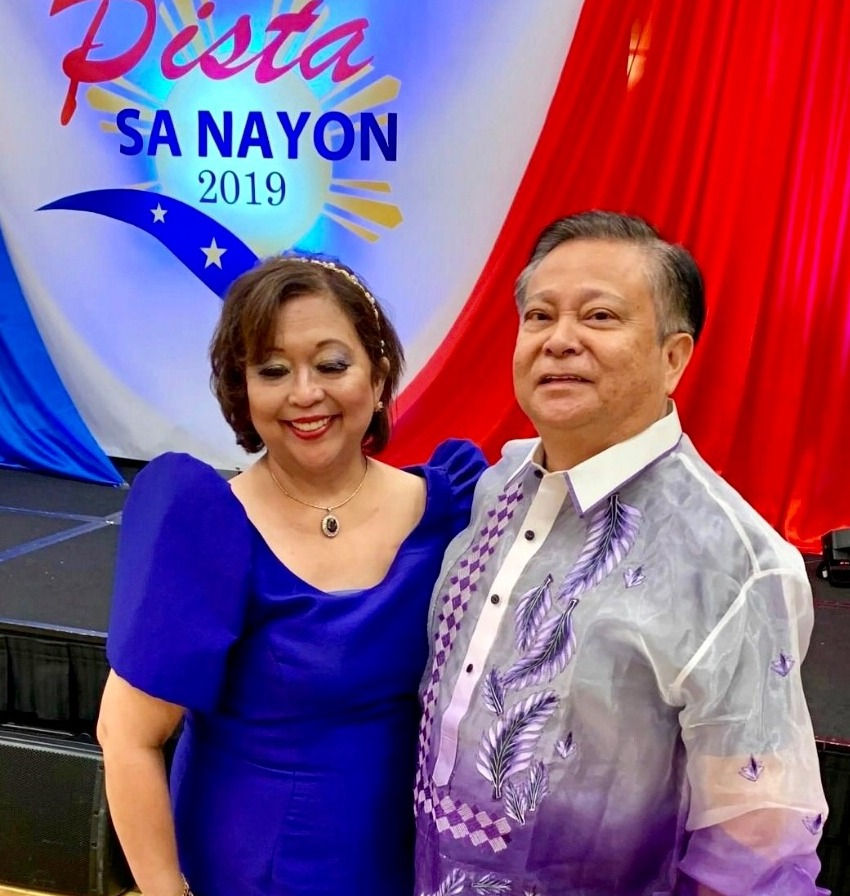
This picture depicts the beautiful "Maria Clara" as a traditional dress for women worn by Maryann Puzon, FFRGOC Board Member - Director of Social Activities and "Barong Tagalog" for men worn by Glenn Puzon, FFRGOC Board Member - Director of Charities, on special occassions like we had last Pista sa Nayon 2019.
"Knoweldge is Power."
We, as Filipinos, want everyone to know us more through this special featured article who we are, as far as cultures, traditions and values. Contributing factors from other cultures i.e. Malay, Chinese, Indian, Arab, Spanish and American influenced also our cultures, traditions and values. It has been said that "Filipinos have an American mind, Spanish hearts and Malay roots. "
It is our goal, as FFRGOC members and officers, mostly of Filipino descent and whose origins are from the different parts of the Philippines, to be respected and considered equal in the eyes of God especially during this hard times of COVID19 pandemic which causes some racism and stereotyping for others. Understandably, when we suffer we try to blame our misfortunes to others.
As "one" organization and in line with our mission statement, we want to propagate faith to God and the Blessed Virgin Mary though the prayers of the rosary through exposure to the social media who we are and wherever we are and is not meant to be a controversial subject matter but merely to get the respect that everyone deserves.
Filipino Morals and Faith Values.
Filipino faith and morals i.e. what is right or wrong, good or bad or important originate from the Catholic Church or other Christian sects and the Islamic religion. The Philippines population is predominantly Catholic and we have other Christian sects and Muslims as well. Everyone respects each other as far as their beliefs and free to practice in the Philippines or wherever countries they migrated or currently work or reside unless in some countries where they are prohibited or restricted.
What is important with these values is they actually guide Filipinos' behaviour and action including how they apply themselves to actual situations in life. But of course, not all are good in certain situations especially when there are other influential factors but overall, early exposure to goodness influence their decision making.
Honor (karangalan):
Honor (karangalan) rather than wealth is an important value to Filipinos. "Amor-propio"is a Filipino emotional reaction to protect his/her honor and dignity when he or she is threatened or questioned and to retaliate properly. "Loss of face" is also another terminology used related to the emotional reaction.
Some Filipinos could be shy or timid and has the "colonial mentality" which is why other cultures perceive them as easy targets for inappropriate actions. But most Filipinos are well educated and accomplished in their own line of work as doctors, nurses, teachers, project managers, engineers, cpas and lawyers, medical technologists, architects and designers or part of management of Fortune 500 companies. Driven also by poverty within the family,and better option to educate their children and members of the familiy, Filipinos migrated/accepted nurturing positions in other developed countries as caretakers and domestic helpers which are much needed by other countries aging/working population.
Filipinos also worked as crew members in the cruise lines similar to other poorer countries like India, Pakistan and other Asian countries. The author in her travels met Filipino chefs, hosts, manager of food dept in cruise lines like Norweigen Cruise lines and the chef even cooked Filipino soup called "sinigang" for our table as a treat to fellow "kababayans"
Thanks to these Overseas Filipino Workers (OFWs) who mmensely helped the economy of the Philippines and the government acknowledged them as heroes and give certain priviledges and rightfully so, when they come home for visit or retirement.
Bayanihan:
"Bayanihan" is the team spirit and mutual cooperation of Filipinos to lend a helping hand to those people in need in the community without regard of being paid in return.

Utang na loob:
"Utang na loob" is another value that Filipinos practice which is a technique to give back gratitude to others but in certain cases can also be abused depending upon the individuals especially if there are selfish motives behind one's actions.
Honorable Welcome Attitude:
"Honorable Welcome Attitude" is another value that has been praised by most people who have actually travelled to the different islands in the Philippines and continued on by generations. Filipinos will offer you food especially they love to eat and share regardless of whether you are a total stranger like on fiestas where a simple home near the roads opens their doors to serve and gives honor to true friendship. Filipinos who reside or become citizens of other countries adopt to their new environment and might not display this outright trait but still embedded as Filipinos.
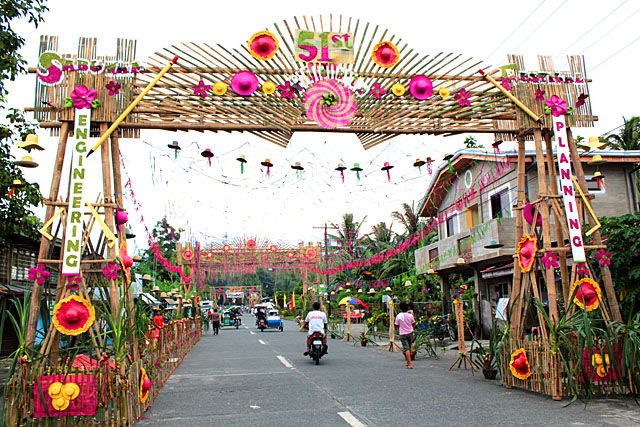
Filipinos like to celebrate Town Fiestas and thank patron saints, an influence by the Spaniards, for all the bountiful blessings including the harvests.
Please enjoy watching below on YouTube the 8 Biggest festivals in the Philippines which are the more popular ones out of 42,000 festivals every year.
Filipinos are cheeful and fun-loving people although could go to extremes in certain cases on these celebrations. Fiestas include parades of town products, flowers and of course there are performances using native costumes.
Religion:
"Religion" is practiced by Filipinos, mainly Roman Catholics, and have deep faith and belief especially when they are well educated in religious-based schools run by nuns and priests. Educational system, public and private, is patterned after the American system complete with books, materials, and computers but not all areas which accounts why thePhilippines is one of the leading English speaking countries. A country that is good for tourism and establishing business centers complimented with the nature's beauty of the different islands minus of course rainy and stormy seasons typical of the tropics. The educational system plus the imbedded values make Filipinos a good "hire" as attested by most employers in foreign countries they chose or allow them to migrate and reside or become citizens of that particular country.
Even Pope Francis had a Vatican Mass to celebrate the 500th year of Christianity for the Philippines as per YouTube video.
There is also a strong presence of the Muslims especially in the Mindanao island. The Philippines is grouped by major islands i.e. Luzon, Visayas and Mindanao. Foreign influence, in the past, infiltrated the Muslim population ie."ISIL which is the "Islamic State of Iraq and the Levant " also known as the Islamic State of Iraq and Syria (ISIS) officially known as the Islamic State (IS) and also known by its Arabic acronym Daesh" and caused destruction of mosques like the Grand Mosque in Marawi City, Lanao del Sur as shown below before the destruction. Reconstruction on these mosques has been ongoing.
The Philippine government , despite the majority of Filipino Catholics, intervened and saved further destructions of mosques and has recognized and respected the Muslims in their beliefs and even have representatives in the Senate and House to protect their rights and beliefs. Respect for everyone is always encouraged despite their roots as to tribes and religions especially the terrain of the Philippine islands has forests and sometimes unreachable.
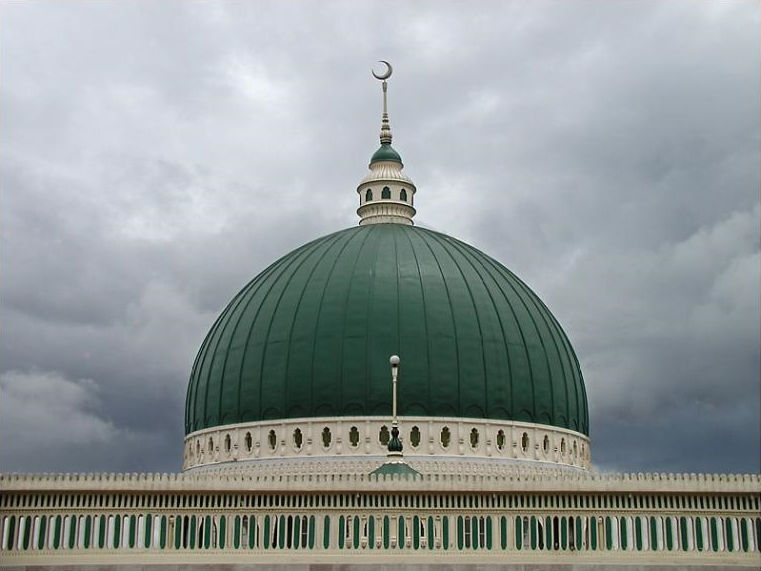
Grand Mosque, Marawi City, Lanao Del Sur
Strong Family Ties :
"Strong Family Ties" is also a value practiced by Filipinos and taught on an early age to be loyal and love their family and elders and obeying them. We always aim to strengthen the family bonding on Catholic, Christian or Muslim holidays depending upon their religion, birthdays, weddings, funerals, baptisms and graduations pre COVID19 guidelines. Currently, these family reunions are curtailed or limited to immediate family members within their bubbles to be safe and healthy at all times. Support system is also established by having homes of different family members cluster in a particular area so each member of the family can share food or help others when needed. This support system is even visible now generation after generation that even a certain "barangay" or township have three or four predominant last names, mostly Spanish, due to ancestry and the author and her family were born to realize this type of cluster which explains why these surnames prevail even now.
Respect:
"Respect" is another value that Filipinos practice especially to elders where we add the word "po" to sentences/phrases when we converse to show respect. When you bow and bring one of the elder's hands to your forehead and saying "Mano Po" that means both ways i.e. you are receiving the elder's blessing and you are showing your respect to elders similar to other cultures when you are kissing their hand or other respect gestures like kissing cheek to cheek and saying "Besos".
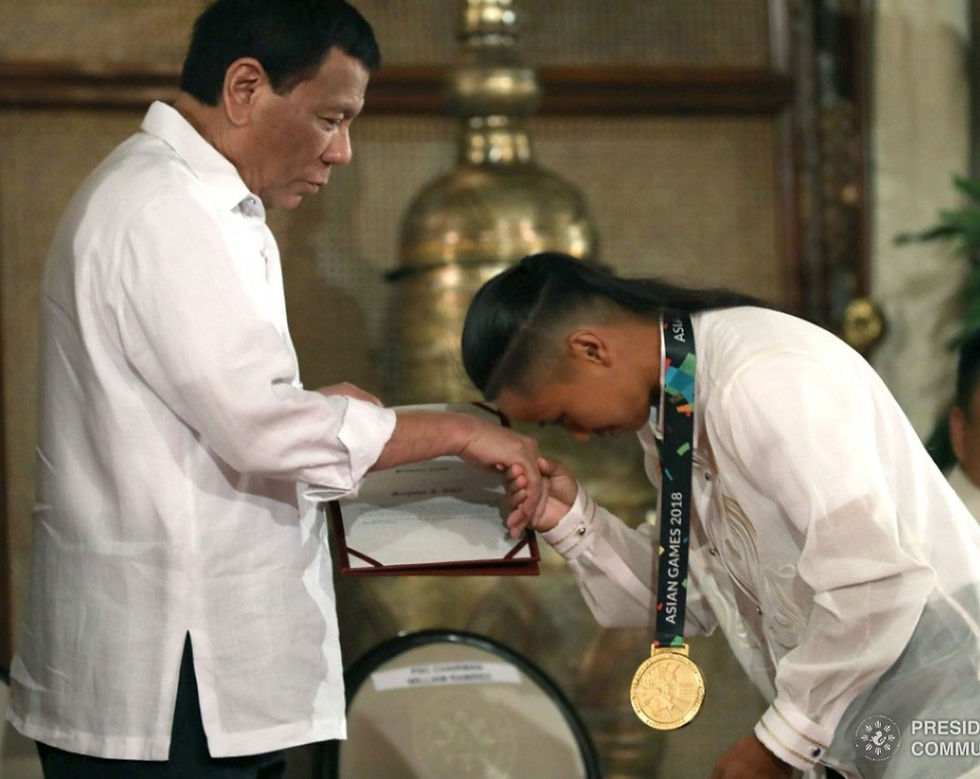
Mano Po
Being Resilient:
"Being Resilient" is a value influenced mainly by tropical and environmental disasters such as typhoons, heavy rains and flooding, earthquakes and volcanic eruptions in the different islands of the Philippines. The results make the Filipinos strong and resilient and have the ability to survive and the basic optimism, flexibility, adaptability , being used to hard work especially those born in poverty and having a strong belief in God making them courageous and optimists. "Bahala na" is an attitude that emanated from these disasters to maintain maximum optimism but not fatalistic at all but rather leave their well being, when nature's disasters strike, to God driven by faith.
Filipinos can be likened to bamboos that are flexible and supple and sway, withstand elements such as strong winds and rains and usually do not break unlike bananas, coffee or mango trees and still stand erect and proud after the disasters. But of course, there are exceptions when Filipinos had been pampered by rich parents from day 1 but most of the Filipinos are resilient.
Filipino Cultures and Traditions.
Language:
The major languages used by Filipinos are Tagalog and English which are also part of the educational system. Tagalog is the first language, an Astronesian language that belonged to the Malayo-Polynesian subfamily influenced by Malay and Chinese and Spanish and American English languages which included the words and spellings in Tagalog. "Taga Ilog" shortened Tagalog literaly means "from the river".
The present 1987constitution called the main language as "Filipino" and now the national official language of the Philippines and is based in Tagalog.
Today, more than 50 million people speaks Tagalog in the Philippines, mostly in the southern parts of Luzon and over 24 million people speaks Tagalog in other countries such as Canada, Guam, United Kingdom, United States and United Arab Emirates and Saudi Arabia mainly because of Filipino migrants and some of them became citizens of those countries.
Other dialects spoken in the Philippines are Cebuano, Ilokano, Waray-Waray, Hiligaynon, Pangasinan, Bikol, Maranao, Maguindanao, Tausug, and Kapampangan. FFRGOC celebrates the Mass in our events by having petitions and readings done in different dialects represented by our officers and members who came from different regions and familiar with those dialects. Even our songs are sang by our FFRGOC Choir in English and Tagalog and other dialects during our events.
Cuisine:
Filipinos love to eat and share which is also part of being hospitable. Filipinos love to cook and take pride of their delicacies which vary by regions and/or islands in the Philippines. Main food that is served is a "suckling roasted pig" commonly called "lechon" passed down by the Spaniards where a young pig is skewered, gutted and cooked whole over charcoal for a few hours and turned constantly while basting to make the skin crisp and still maintaining the juices and softness of the meat inside. Hawaians roast their pig by making an underground oven called "imu" and placed their pig to roast covered with banana leaves and also roasted for several hours in a luau setting and results are similar per the author's personal experience.
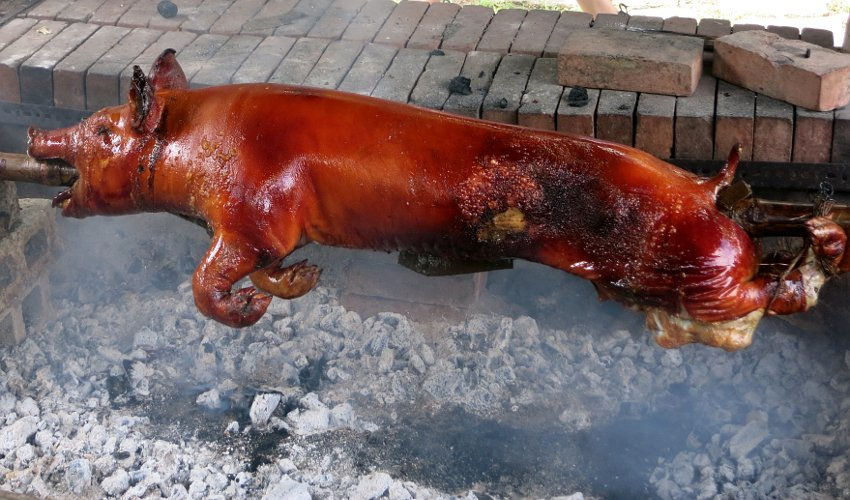
One popular food to Filipinos and other cultures is the adobo. as shown below, originated from the Spaniards during the 1800s. It can be pork, or chicken or both cooked in a mixture of vinegar, soy sauce, whole black peppers, bay leaves and sugar to taste. Some also add potatoes and pineapple chunks and others marinate the meat on a mixture of citrus juice called "calamansi" and soy sauce before cooking. Based on the author's observation and availability of recipes from the internet, people from Southern Luzon cooks more delicacies that have European flavor be it Italian or Spanish.

In the Northern Luzon specifically the North Ilocos region, "pinakbet" is a favorite vegetable dish which includes okra, string beans, eggplants, bitter gourd or "ampalaya" and squash sauteed in garlic, onion, slices of pork or grilled fish and seasoned with fermented fish called "bagoong".
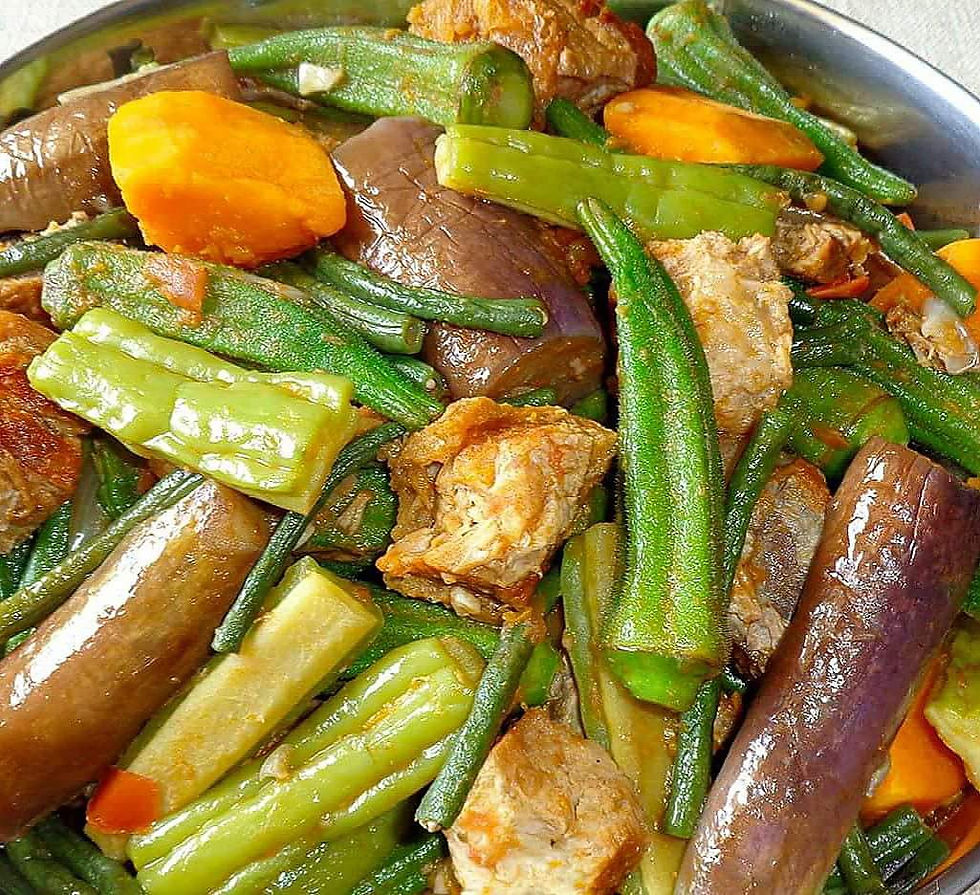
In the Bicol region which is part of the Southern Luzon, natives of the area cook "curry type" food because of the abundance of coconuts, called "Laing" which is taro leaves cooked in coconut milk with slices of pork, chilies, garlic and shrimp paste (Bagoong).

Another specialty from the Bicol region is Bicol Express with sauteed pork in garlic and onions and added coconut milk plus chilis and beans which is similar to Thai curry dishes.

In Zamboanga, located in Mindanao, their favorite food is called Satti, a breakfast food and has small strips of barbecued roasted beef and chicken liver on a stick served with peanut sauce and rice cakes and a favorite of Muslim Filipinos.
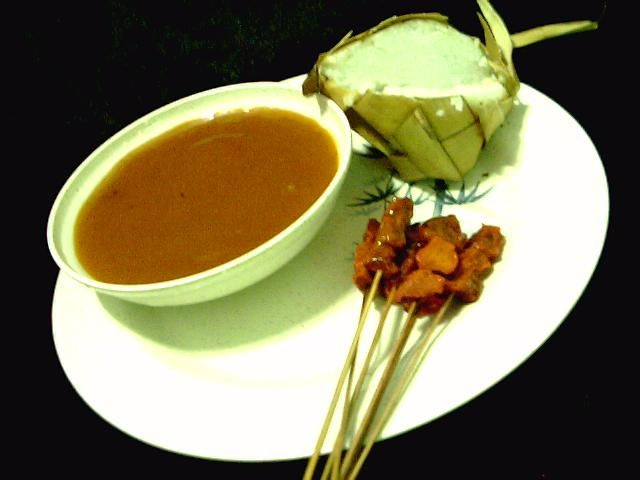
Also found in Zamboanga is a crab called Ranina ranina commonly called "curacha crab" or "red frog crab" which is either steamed or cooked and served with a special sauce. The meat is what they are famous for which is inside the body of the crab which some says they taste better than a lobster or a crab and the author agrees.

Other famous Filipino dish is pancit guisado - glass noodles with meat and vegetables
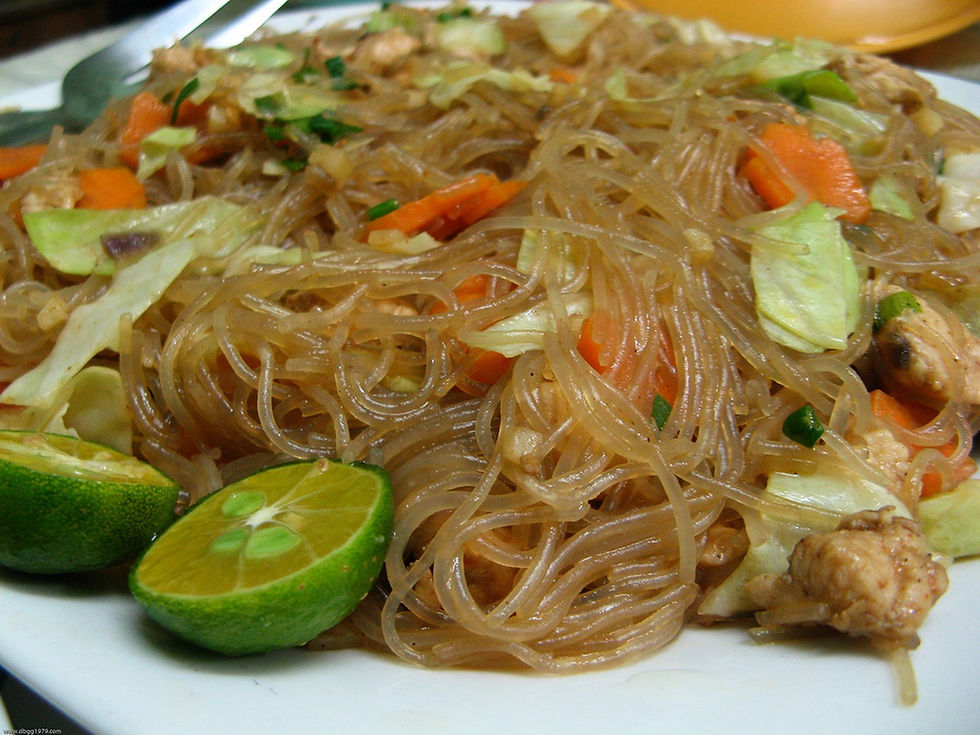
and beef steak marinated in citrus juice called calamansi and soy sauce and pan fried with onions called "Bisteak".
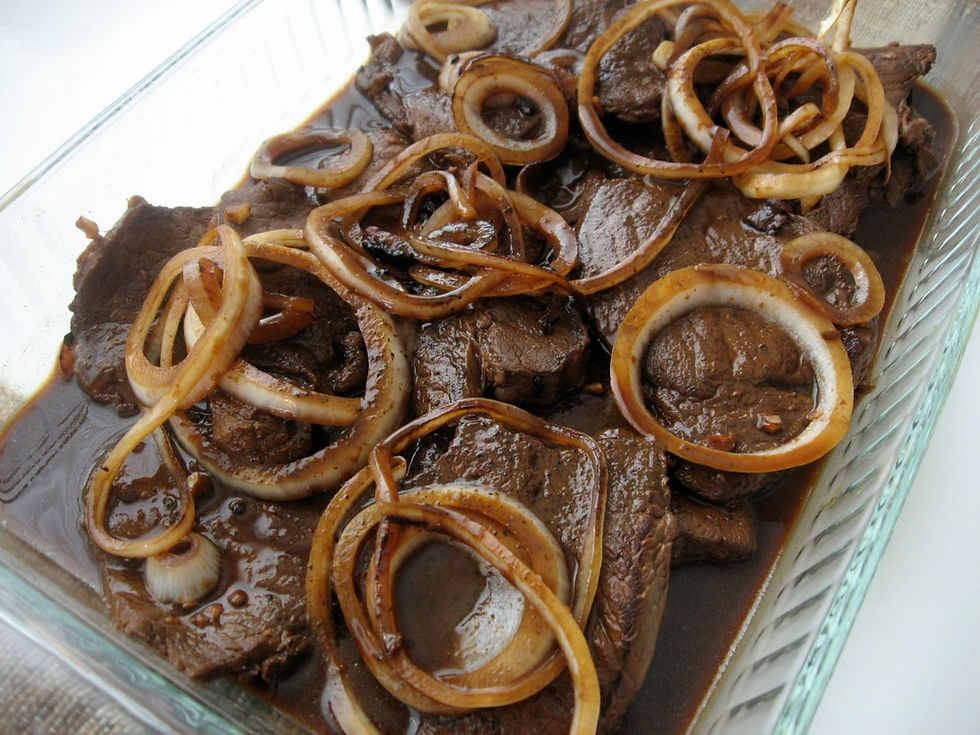
For cold weather, we have soup called "bulalo" with beef shanks, corn, potatoes and napa cabbage and beans cooked in slow cooker and other cultures love it.
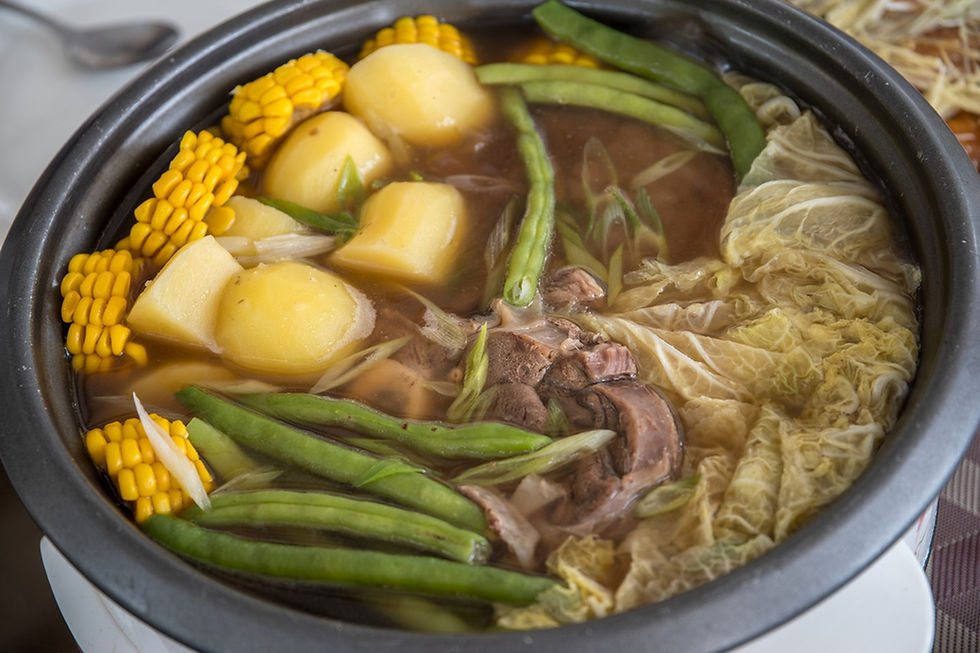
And, last but not the least, is the Filipino eggrolls called "lumpia shanghai" dipped in sweet and sour sauce and popular among other cultures and quite different from other Asian eggrolls. .
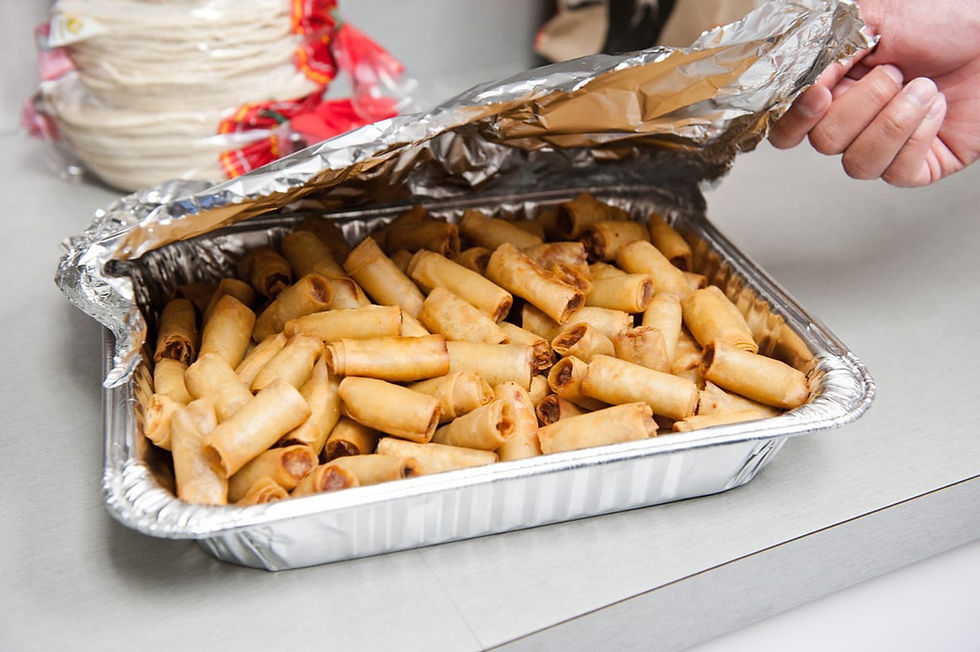
Music:
Filipinos are very talented and have the charm as entertainers and love to sing and dance. As part of recreation and unwinding from stress, most Filipinos own Karaoke machines in their homes to belt out some songs and before the pandemic, Filipinos were "regulars" at restaurants where they have karaoke and anyone can sing with the aid of a song book and others opted to dance with the music. Most Filipinos have good voices to sing and play different instruments which account for the presence of a lot of entertainers in Japan, Hawaii, Las Vegas and luxury ships like the Norwegian Cruise Lines.
Almost all churches all over the world have Filipino choirs and Filipino dance troupes. Most Filipino choirs sing in English, Latin, Spanish and Tagalog songs which is part of their repertoire. Filipinos can dance modern as well as Filipino folk dances which include Tinikling, Pandanggo sa Ilaw, Sayaw sa Banko to name a few. FFRGOC choir members have done folk dances and sang in different languages during our events wearing their beautiful ternos for women and different colors and weaves of barongs.
This year, Gabriella Sarmiento Wilson, better known professionally as H.E.R. won the Grammy "song of the year" award. She is a Filipino-American singer and song writer. She was the guest singer who sang "America the Beautiful" last Super Bowl LV. She grew up in Vallejo, Ca and attributes her talent to her dad who is a musician and her mom who is a Filipina. "I am half- Filipino and Filipinos love karaoke" she said. "So yeah, I love to sing, I've always been around music my entire life and I just gravitated towards instruments."
Famous Filipino celebrities as singers, actors, actresses and WWE boxer and actor in Hollywood have Filipino blood in them like Bruno Mars, Enrique Iglesias, Vanessa Hudgens, Michael Copon, Alec Mapa. Nicole Scherzinger, Dante Basco, Darren Criss and Hailee Steinfield.and Dave Batista.
Social Habits.
Filipinos celebrate New Year with a "bang"! Each New Year's Eve, Filipinos gather together with their families on December 31 to share a meal called "Media Noche".
Please follow the link for the 13 quirky traditions Filipinos do during New Year published in Gulf news based in Dubai.
Filipinos also have the longest Christmas celebrations. Being fun-loving and faith-centric individuals, we like to celebrate the coming of Jesus on Christmas. As early as August, Christmas songs are played on commuter buses and jeepneys, stereos and televisions at home, restaurants and as piped in music in the malls, a favorite hangout, for people especially pre Covid19. Mood is festive and people are dressed up using Christmas colors in red and green while shopping on a fully decorated mall. Beautiful lighted Christmas lanterns shaped usually like a star called "parol" of different sizes and colors are used to decorate the streets and malls and houses at night and some churches also have their own decorations.
Most Filipinos think of Christmas not as gift giving but sharing this special holy day with family although the younger children think more of gifts. For Filipinos, like the author, and residing in other countries, they prefer to spend their Christmas in the Philippines to enjoy food like exotic Filipino dishes and tropical fruits that usually are not available in other countries like "lansones", have a cooler climate and enjoy the warm beaches and go shopping in different decorated malls. Eating in nearby restaurants and listening to Christmas piped in music complete with lights display in Ayala complete the night out with friends and families.
Arts and Architecture:
Filipinos are creative in their design, intuitive in their thinking and passionate to do something different and unique in arts and architecture. Historic and cultural influences from the Spanish, American, Chinese and Austronesian is visible on our buildings, churches, mosques, cathedrals and houses minus those that were destroyed by natural disasters and caused by conflicts of people between Muslims and Christians In the islands of Mindanao.
The Augustinian friars, along with other religious orders, built many grand churches and cathedrals in Manila and suburbs and in the different cities of Luzon, Visayas and Mindanao. There are still churches standing today despite all the typhoons and earthquakes like the
Taal Basilica in Taal, Batangas which the author has personally visited. Considered one of the biggest church in Asia, it is built as a neoclassical architecture. Construction finished in 1878 but continuous reconstruction is ongoing as shown in the pictures below.

Taal Basilica - Front View

Taal Basilica - Interior View
Typical houses built were "Bahay na Bato' or "House of Stone." These houses were built combining Spanish- style solid heavy stone or bricks for posts and foundations and walls, Chinese - style tiled roof plus the design and use of overhanging eaves like the Gamble House in Pasadena in order to protect the residents from the elements such as wind and sun which is typical to a tropical climate. House was also elevated to prepare for stormy season and built with stones or bricks and strong wood for earthquake-proof construction. The use of local materials that were in abundance such as capiz shells, a touch of Filipino style, on sliding windows made the houses have better open ventilation during the hot season. Also the penchant of building houses in a rectangular shape is Filipino style.
Jose Rizal's, our national hero, house typified the building of "Bahay na Bato" in Calamba, Laguna which the author has also actually visited.
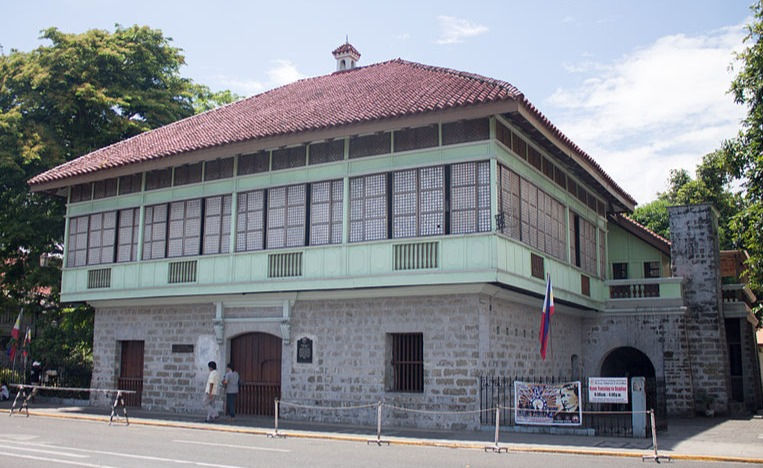
Jose Rizal 's House
After the Philippines was ceded to the United States as a consequence of the Spanish-American War in 1898. the architecture of the Philippines was dominated by American influence.
Below is the exterior and interior of the Manila Army and Navy Club, the first American Social Club, for the use of US Military and Navy Personnel which later was also used by Filipinos. This building was designed by Williams Parson and completed in 1911.
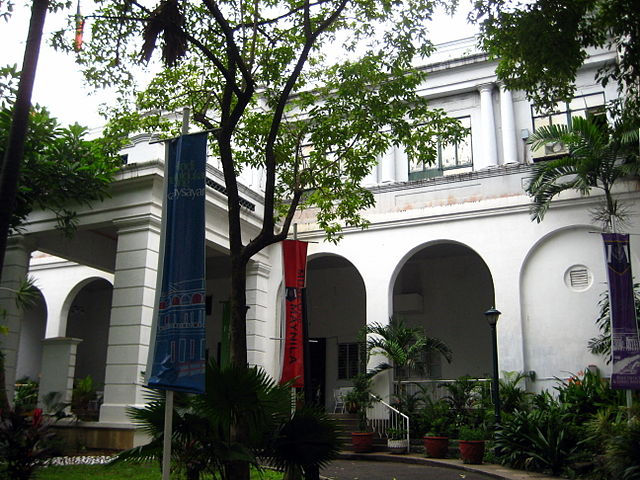
Credits to By Ramiltibayan - Own work, CC BY-SA 3.0

Credits to By Ramiltibayan - Own work, CC BY-SA 3.0
To date, top five-star hotels like Grand Hyatt have branches in the Philippines displaying the influence of American modern architecture .
Below is the YouTube featuring the 5 tallest buildings in the Philippines showing the influence of American architecture.
Conclusion:
In conclusion, the Philippines is a tropical country that boasts beautiful islands and different colors of sandy beaches, waterfalls, forests and a place worth visiting be it business or pleasure.
It is our goal that you have enjoyed reading and watching videos of the Filipino rich cultures and traditions and values and most of all gained your respect as equal in the name of God.
Thank you Dina and FFRGOC is very pleased with your positive feedback. Hope to see more of you in the future. 😍
Happy to be a part of FFRGOC at some point in my youth and now happy to still be here, very proud of the accomplishments of the board members, the volunteers and its area leaders and most of all our Priest, past, present and Future. Please continue. We are proud of you. God Bless and Loves all of us, Dina T.